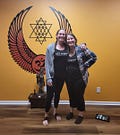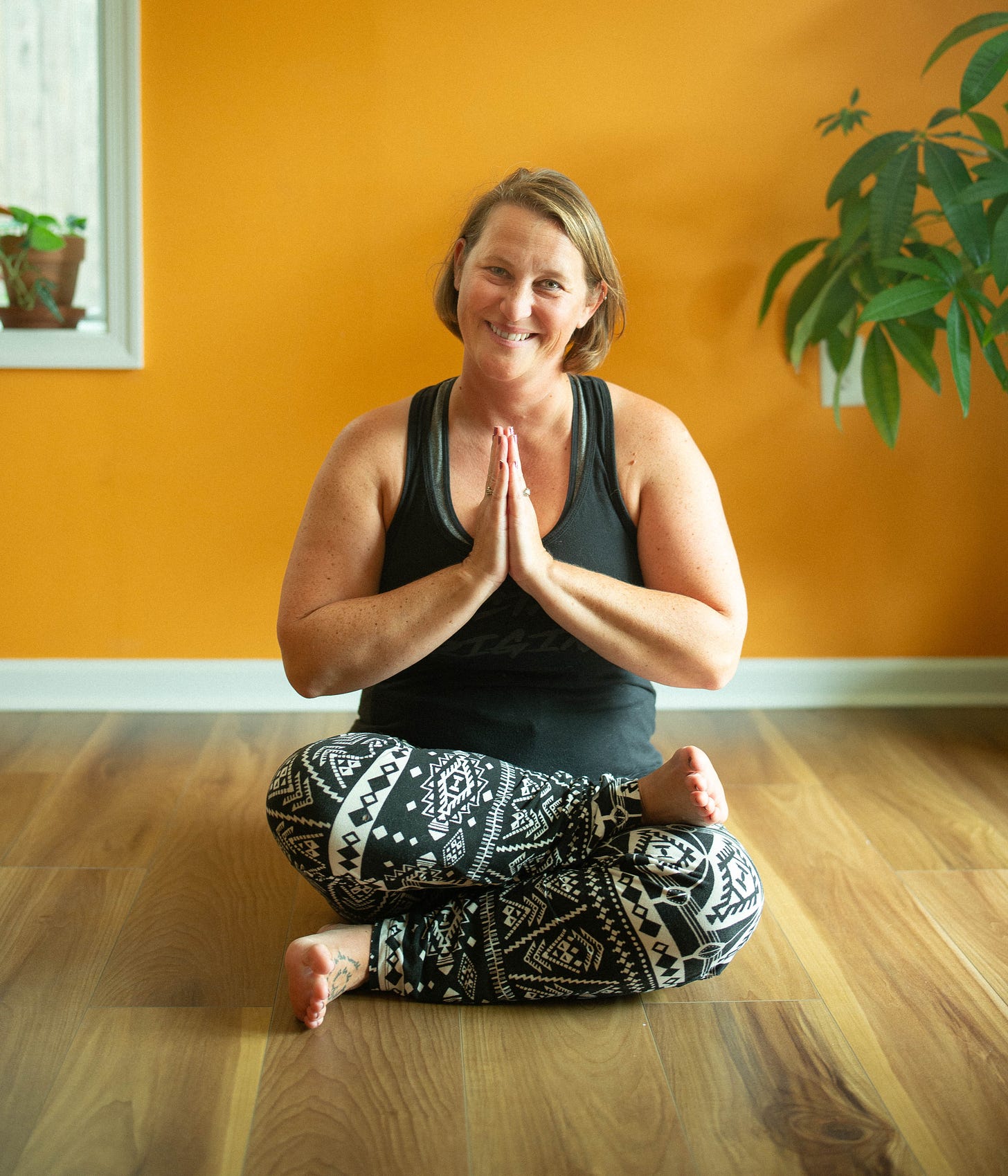The timing is strange and serendipitous that Julie asked me to reflect on How Yoga Keeps Me Sober this week. It was during this season, in October about 5 or 6 years ago, that I finally decided that I didn’t need to drink alcohol anymore.
Alcohol was always about fitting in and it took me into my 30s to finally become empowered enough after a Halloween party to say confidently, I’m done.
Drinking hadn’t been fun for years. My mind and body preferred hot tea but up until then, I was afraid of being different or seen as weird or a buzzkill. Through yoga, I discovered how to embrace myself fully and give up caring about going along with the group.
Also timely and ironic, I’m prepping for a colonoscopy as I write this. It’s not ironic because this will be a crappy post, it’s ironic because my first colonoscopy 13 years ago is what led me to discover yoga. And yoga led me to find healing physically, mentally, and spiritually. And that healing led me to find the strength to get and stay sober.
So we could say that yoga helps keep me sober - or maybe it’s all the shit I have dealt with throughout my life that led me here to this place of peace.
Yogis would say it’s all connected. Everything is a lesson for our evolving soul.
How I Found Yoga
Back in 2011, my thoughtful and thorough primary care doctor recommended that I try yoga during my last appointment with him before I moved out of Washington, DC. We had built a relationship over the previous few years as I saw him often. I first went to him for my intense and increasing migraines. WebMD had me fearing tumors or cancer but we never found a specific cause of the bombs going off inside my skull.
Then the extreme intermittent stomach pains started; they were torturous. Without warning, a searing sharp pain would tear through my organs, bringing me to my knees, but it never lasted long.
The first time it happened, I was at work, alone in my office, and I considered calling an ambulance even while knowing I couldn’t afford it; the intensity was shocking. I pushed into my belly with my hands and curled up to use my knees as additional reinforcements hoping the pressure would assuage the burning sensations and extinguish the fire in my gut. A few minutes later, again without warning, the pain disappeared. Vanished, with no lingering effects. So I got up and went back to work as if I wasn’t just laying in the fetal position next to my desk.
I submitted to many tests but none found a specific cause. Just like the migraines, my doctor said the pain might be stress-related. Work and life were stressful but did my mind have that much control over my body? I couldn’t believe that.
When I went to see him because of the massive red hives that broke out on my stomach and torso, fearing an allergic reaction, he took a book off his shelf to show me my hives pictured on the page titled Stress Hives.
I had to concede that my life was becoming unmanageable. My body was telling me I had to make a change. My job and my environment were killing me. Gratefully, a few months later I found a way out and moved for a new job closer to home.
In that last appointment before leaving the city, he gave me a script for a colonoscopy, along with a hug. His parting words I’ll never forget. “Do try yoga, it’s a powerful practice.”
How My Teacher Found Me
My migraines stopped almost immediately after moving and the colonoscopy my doctor ordered discovered a stomach ulcer which diminished after I made slight diet changes and left that stressful job. With free time allowed by my new job, I practiced yoga 3-4 times a week and felt the benefits quickly. The workouts kept me sweaty and coming back, enjoying the dopamine rush. I felt good, better than I had in a long time.
But yoga is expensive so I bought Groupons and tried out different studios, following the deals. One auspicious day, Groupon brought me to Nectar Yoga where the energy felt different. It wasn’t a hot studio and the people weren’t homogenous.
The teacher began with chanting Aum and a dharma talk, providing wisdom about the mind-body connection. My ears perked up as I was learning in real time about the power the mind had over the body. At the end of class, the teacher chanted a Sanskrit mantra: Lokah Samastah Sukino Bhavantu. Her translation was: May all beings everywhere be happy and free from suffering and may our thoughts, words, and actions, in some way, contribute to that peace and freedom for all.
When she finished singing, my whole body was buzzing. I was home. I found my teacher.
How Yoga Healed Me
While I started yoga as a physical workout, I quickly learned that the body is not the intended target of the practice. Patanjali, an Indian sage, was credited as the author of the Yoga Sutras around 200 BC. The first line of the sutras is translated to: the purpose of yoga is to still the fluctuations of the mind. When I learned this I was floored and thought: Yoga is about calming the mind? Then why do I see so many people stressing out about making pretzels with their bodies as if that’s the pinnacle of the practice?
Through practicing with Kate Goodyear, I learned that yoga is a mental and spiritual practice, not just a physical one. The physical stuff is all a mental test, a practice for your mind, and serves as a measure of your ability to control your breath.
The Yoga Sutras has 196 stanzas, or sutras, that serve as a philosophical guidebook for being human. Out of the 196 sutras, only 3 mention asana, or postures, and it says the postures are done to ensure the body is capable of sitting in meditation for long periods. I was blown away by what I was learning and it all clicked and made sense.
She taught me about the eight limbs of yoga which start with moral ethics including five ways to treat others (1. yama) and five ways to treat ourselves (2. niyama). In addition to the postures (3. asana) in class, she teaches breathwork (4. pranayama) which I find extremely helpful in calming my nervous system and stopping my automatic reactions. I’d say the breathwork alone has drastically improved my life.
I’m still working on withdrawing attention away from my senses (5. pratyahara), deepening my concentration (6. dharana), and finding stillness in meditation (7. dhyana) in the hopes of one day (maybe in a few lifetimes from now) I might reach nirvana (8. samadhi).
My teacher often reminds us in class to pay attention to what our mind says to us when we’re moving. “In a challenging pose, how does your mind react? Those tendencies follow you out of the studio so practice here to recenter yourself using your breath. You have the power to pause, to question, to change your thinking.”
The techniques I learned on the mat were taken off the mat and helped me overcome physical ailments, mental anguish, and past trauma.
Yoga is a powerful practice, as my doctor predicted. It’s helping me to live my best life.
How Yoga Keeps Me Sober
The more I learned, the more I wanted to learn.
Understanding the first two concepts of the yamas: non-harm (1. ahimsa) and truthfulness (2. satya) as guideposts opened my eyes. The way I was living was causing myself harm and I wasn’t living my truth. I was following the crowd, trying to fit in, and I didn’t like myself because of it.
I didn’t want to smoke cigarettes anymore. I didn’t want to drink anymore. I didn’t want to hang out in bars anymore. None of it fit who I truly was or wanted to be.
My teacher says that the more you practice yoga, the easier it becomes to let go of the things that no longer serve you. It was true for me and it started with having an easy excuse to not drink or go out: I can’t, I have a yoga class in the morning.
I began meeting people who also preferred flavorful tea instead of booze and it became even easier to make the healthier choices that I wanted to make. I attended yoga workshops and retreats on weekends and have formed deep friendships. Real ones. Not like the ones who stopped calling me once I stopped going to the bar.
I started leading satsang at the studio which is a philosophy discussion group and even began Sober Socials once a month. They’ve been a huge hit! All of it proves that I was in the wrong crowds before and I needed to find my community.
Through the practice of self-study (2. niyama, #4 svadhyaya), I examine my choices now. I am more reflective, and I write more often. My book and subsequent Substack Write to Heal, developed as a practice of self-study and is made as an invitation for others to take up that practice for themselves.
So I’ll leave you today with one prompt:
If you lived your life following the guides of ahimsa (non-harming to yourself or others) and satya (living as honestly as you can), how would your life change?
A Bit More About Me ~ Author’s Bio
As an author and advocate for health and healing, I’ve spent the last four years on a mission to empower others to find the peace and purpose I discovered through writing, yoga, and vulnerable story-sharing. I describe these three powerful healing tools in my 2023 book, Fragile Thoughts: A Healing Memoir which is both a personal narrative and practical guide with thoughtful journal prompts and traditional yoga-based activities ending each chapter.
My book includes insights into how I found and sustained sobriety, how I met and married an amazing man in recovery from substances, and how we manage the challenges and bolster the joys of our beautiful life together. Through it all, it’s writing, vulnerability with others, and the spiritual practices of yoga that keep me grounded.
Additional Posts About Substance Use and Sobriety ~







Well said Katie! Thank you for stepping in. I found a lotta wisdom in your piece.
I hope your colonoscopy went smoothly with solid results... I think these subconscious colonoscopy puns are running with ease because I had my own yesterday.
Love this Katie! (And Julie!) Yoga and the practices of non-harming and living honesty are essential to my spirituality, my ethical compass, and my sobriety. Without yoga, I’m not sure I would’ve recovered from anorexia. And I probably would’ve taken much longer to quit alcohol.